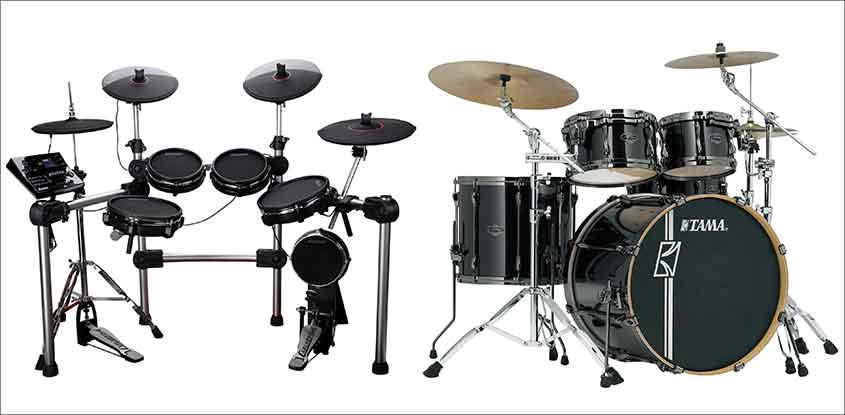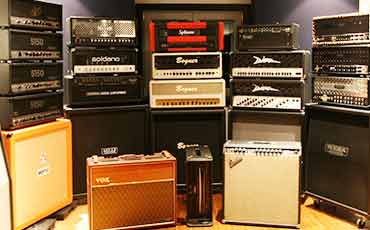It is much easier to learn & achieve accurate dynamic control on an acoustic drum kit. But nowadays most sophisticated electronic drum kits also offer the same by using advanced features and a bit higher learning curve.
Digital Drum Kits: Extra Silent
When it comes to sound control, electronic drum kits certainly have the edge. Acoustic drum kits have bass frequencies as low as 40Hz which penetrates most walls and obstacles. Therefore, practicing on an acoustic drum kit is quite impractical in an apartment complex or within a calm neighborhood, especially at night. But electronic drum kits come with breathable mesh drumheads, rubber or silicone pads that dramatically reduces the level of ambient noise, making them ideal for playing at home, stage or at a worship platform. Due to this fact, you’ll need to have a set of headphones, amplifier or a PA system ready for any practice, jamming or performance.
The Price Point
Acoustic drums from reputed brands are pricier than their Digital counterparts. Also, acoustic drum kits require additional purchases like cymbals which adds to the total cost. For most beginner drum students, this will be too expensive to start with. But superior quality digital drums from well-respected brands like Yamaha, Roland, Carlsbro, Alesis & Behringer, with all the required components can be purchased at a fraction of the price of an acoustic drum kit.
A Very Small Footprint
A complete acoustic drum kit occupies some space to be set up. The entire acoustic kit would also be heavy to move around, once set. For people who live in small apartments or rented out places with space constraints will find it difficult to designate this much space. But most of the digital drum kits come mounted on a single foldable frame which makes them occupy very small space and can be tucked away when not in use. It also easy to change its position in the room, even when fully mounted as they are also light weighted.
Well Contained Sound & Option To Go Completely Silent
Acoustic drum kits produce sound by the impact vibrations on their batter heads (skin) and these sound waves can be very loud and would easily penetrate the walls and travel to the neighborhood. Nobody likes their neighbours come knocking & complaining about you practicing Metallica at midnight! There are a few contraptions available to mute the acoustic drum kits to a certain level, but none are 100% effective. This means that you need to schedule your practice or playing hours so that you are not bothering your neighbours.
Digital drums on the other hand, produce sounds electronically and not acoustically. This enables you to completely go silent to the outside world by plugging in a pair of headphones. Bang it how much ever you want anytime and your neighbours wouldn’t even know that you are there!
Easily Pack & Transport Anywhere
Digital drum kits are completely collapsible to component level so that they fit snuggly in their packaging cartons. Most of them weigh less than 40 Kg and could easily fit even in a compact car’s boot. So, packing and moving them anywhere is as simple and effortless. The same cannot be said about an acoustic kit and most of the time you might require some kind of assistance.
Sound Versatility: Same Kit, More Sounds
If you require a Timbale or an Octaban sound on your toms and an 808 on your kick, it is very easy on your electronic drum kit as it comes with a multitude of Sound Patches which are editable and assignable. They will also have some additional drum kits for every popular genre, ballad to blues. Even the best acoustic drum kit can’t deliver such diversity provided by a modest electronic kit. This makes them an excellent choice for cover bands and recording artists. Some electronic drum modules even allow you to add your own extra drum sounds via cards or ports.
Easily Record Your Drum Multitracks With No Mics
Miking and recording an entire acoustic drum kit is an expensive affair and it takes years of experience to get it right to an acceptable level of quality. Also, you require multitude of mics which are costly. But most electronic kits deal with this in 2 discreet ways, a Direct Audio Output and/or a MIDI/USB Output.
Most electronic drum modules have an output for the 2 Track Stereo Audio Mix to a computer interface for recording. More advanced electronic drum kits will let you record Multitrack Audio (separate Kick, Snare, Toms, Hi-Hats and Cymbals) via a USB connection.
MIDI Compatibility
Some digital drum kits have another way to record your performance as MIDI data. You’ll see this facility on intermediate electronic kits as either a 5-pin DIN connector, which requires a simple MIDI interface to connect to the computer, or a streamlined USB-MIDI connection, which plugs directly into a compatible laptop or desktop computer.
Recording a performance as MIDI rather than Audio gives you the great option that allows you to completely edit or even totally use various other drum sounds for your individual kit components in the future. This also allows you for advanced editing processes such as quantization and tempo adjustments to your performance.
Sound Editing And Upgrading
As mentioned earlier, many Digital drum modules allow you to edit every kit sound parameters and save them as User Presets. Some modules permit you to create and add your own extra drum sounds via cards or ports.
Upgrading The Accessories
Most kit components on the Digital drum kits are upgradable, means you can change your 8” Kick Pad to a 12” Kick pad with a more advanced kick pedal or a Double Kick Pedal at any later stage. This allows you to upgrade your kit without conceding any extra floor space.
The selection between different types of Drum kits is an individual choice, but if you still have doubts regarding your Drum Kit purchase or set up, our expert sales engineers at Musicians Corner will be happy to help you.



